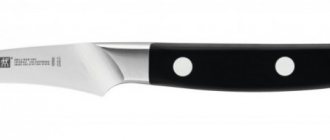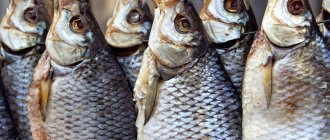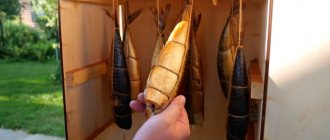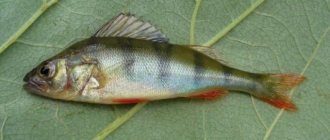Hi all! The section “Life hacks for fishing” continues its work. Any fish can be cleaned in just 1 minute! Just imagine that 2-3 kg of fish is cleared of scales in less than 5 minutes!
Everyone knows very well that cleaning fish at home in the kitchen is not very convenient. Especially river fish with small scales, for example perch.
Of course, when fishing or in the yard, let the scales fly in different directions. What about at home? The scales can scatter in different directions, and then go and collect them all over the kitchen.
To prevent scales from flying
Many housewives are interested in how to clean fish without the scales scattering all over the kitchen. First you need to prepare a place on the table by placing a cutting board and a sheet of paper or newspaper on it. Then you need to pour boiling water over the carcass. Thanks to this, the removed scales will not fly apart, but will stick to the newspaper or sheet of paper placed under it. To be careful, fins and tails should be cut off.
General information
Preparation process
- Before you start working, you should put disposable gloves on your hands and wrap the cling film or bag around the cutting board. With this you can protect your hands and the surface of the board from the fishy aroma, which is then very difficult to remove.
- It is easiest to clean a fresh carcass. If the catch has just been caught, then you need to get rid of the scales immediately.
- To prevent the fish from slipping out of your hands, you can rub your hands with table salt instead of gloves. It is important that there are no scratches or other damage on your hands, otherwise you will experience unpleasant sensations.
- The fish must be washed in water, and then its head and fins must be cut off.
- It is necessary to clean the scales and remove the giblets from the fish on the same day, and in what order this is done does not matter.
REFERENCE! If the fish skin becomes dry during cleaning, simply moisten it with water and continue.
Drill
Removing scales with a drill is a fun way to prepare fish for cooking. It is especially suitable for careful interaction with perch or other inhabitants of the underwater world with small and strong scales. This method was invented by fishermen. You need to prepare a thick wooden board and nail a long nail to it. It is used to secure the fish's head.
You need to attach a brush with metal bristles to the tool, turn on the drill at slow speeds, after which the process begins. You do not need to hold the tail in your hands, but use pliers for this. It is better to use the method not in an apartment, otherwise the entire kitchen will be contaminated with flying scales. It is recommended to cover the carcass with a wet cloth first.
Boneless fish: list, names
- There are a large number of fish that do not have a developed skeletal system. They are often caught by experienced fishermen and then sold on the market. After all, buyers prefer to purchase carcasses, the preparation of which will take a minimum amount of time.
- Next, we will look at the most famous boneless fish. After studying the information in detail, you can make your choice.
There is no such thing as a completely boneless fish.
Shark
- We can say that this is the most famous cartilaginous fish. It became popular after dozens of horror films. But, remember that not all sharks are dangerous. They are found in all parts of the world. But residents of not all countries catch sharks for cooking purposes. That is why they are considered a delicacy. You can often find shark soup in the most famous restaurants. Some of them have been awarded a Michelin star.
- A distinctive feature of sharks is that they have no bones. The skeleton consists of cartilages that are fused together . Due to the fact that the cartilages are mobile, the fish moves quickly and quickly grabs prey.
- If you decide to cut up a shark, it will take a minimal amount of time. The cartilaginous skeleton is quite large, so removing it from the flesh is not difficult. The largest shark is the whale shark. It can grow up to 20 m in length. And its weight exceeds 30 tons.
Beluga
- This fish is considered the largest of the freshwater family. The length of one carcass can reach 10 m. Beluga can often be found in the Black, Azov and Caspian seas. It also lives in large rivers - Dnieper, Danube, etc.
- The beluga skeleton consists of only one bone (the ridge), which does not give off any branches. The skeleton also consists of cartilage, which facilitates movement in water. If you decide to fillet the beluga, it only takes a matter of minutes. The skeleton of the fish is quite fragile, so it is easy to remove all the cartilage from the flesh.
- Remember that catching beluga is prohibited. It is included in the Red Book of the World. Therefore, it will be quite difficult to try its meat.
Stellate sturgeon
- This fish prefers deep waters. It is characterized by an elongated body and belongs to the sturgeon family. The skeleton consists of a chord of bones and small cartilages. That's why it was included in the list of boneless bones.
- Sevruga is included in many dishes because it has tasty meat. This fish is found in rivers such as the Volga and Danube. Fishermen also met her in the Black Sea.
Sterlet
- This fish is found in the Black Sea and Caspian Sea . It belongs to the Sturgeon family. A skeleton consisting only of a ridge supplemented with small cartilages.
- The skeleton does not contain bone vertebrae. Therefore, milling it is not very difficult. Fishermen catch sterlet even before it is fully ripe. For this reason, the fish population has dropped significantly over the past few years. Despite this, it is often caught because it has very tasty and low-fat meat.
Very tasty
Sturgeon
- This type of fish prefers to live in fresh water. Often found in central Europe.
- The sturgeon spends some time in the salty seas, where the spawning process takes place. Sturgeon is a fish that lives a long time. Some specimens lived for more than 100 years. The fish lacks bony vertebrae, but does have some cartilage.
Thorn
- Often this fish is caught on an industrial scale. It is found in the Caspian and Azov seas. But, during spawning, she swims to fresh water.
- The skeleton consists of five rows of plates that only resemble bones. In the 20th century, so much of this fish was caught that it is now included in the Red Book. Up to 6 tons are allowed to be caught annually.
Macrurus
- This type of fish prefers to live in deep waters. To catch her, fishermen go to the Pacific Ocean. The appearance of the fish is quite unusual. The tail section is very long, no more than 2 cm wide. Therefore, the head appears disproportionately large.
- Grenadier meat contains many vitamins, micro- and macroelements. But the danger of this fish is that it has sharp scales. Therefore, it is often sold pre-cut. The skeleton consists of a single tail bone. The meat has a delicate pink tint. The taste is pleasant and delicate.
Burbot
- This type of fish is a bit like cod. Found in fresh water. Often found in Asian countries, particularly Mongolia and China.
- The skeleton mainly consists of cartilaginous formations. The fish fillet has no small bones, and the body is covered with small, non-sharp scales. Therefore, burbot is one of the most popular fish on an industrial scale. Burbot meat is very tasty. It contains many vitamins and minerals. The fish is very prolific. Therefore, there are no restrictions on the number of individuals caught.
Acne
- Despite several types of eel, this article will focus on the marine predator. It is not difficult to distinguish it from other marine inhabitants - its body resembles the structure of a snake. The body does not have a complete skeleton consisting of bones.
- The eel has about 150 vertebrae in its body, but no ribs or small bones. Eel meat is often found in Japanese dishes. It is very tasty and nutritious.
A common component of rolls
Mullet
- Another fish that lacks small bones is mullet. Lives in America, Australia and South Asia.
- The components of the skeleton are large plates designed to transport the spinal cord. But there are no small bones in the fish.
- Mullet is a fish with dietary meat. It is very tender, tasty and does not contain fat.
With serrated sharpening
This is the name given to the special teeth that are located on the edge of the knife blade. The most popular types of sharpening are wave and sawtooth. The uneven size of the teeth makes it easy to clean any carcass, and their cleaning capabilities are not impaired due to high-quality sharpening. They also allow you not to put in a lot of effort when preparing an underwater inhabitant for cooking. Among the disadvantages, cooks note that the scales get stuck between the cloves, and also the fact that it is not possible to sharpen them yourself at home.
How to quickly remove scales from fish with a spoon or fork
The most efficient, effective, fast, affordable and easy way is with a spoon or fork. So I advise you!
The fish is processed quickly and the kitchen remains clean! The scales remain on the spoon, and large crucian carp or crucian carp are cleaned in half a minute!
- Place the fish in a bowl
- pour water just enough to hide the fish,
- take a teaspoon and begin to rake the scales from the tail to the head.
And so, in theory, you can try in any other way. Or maybe some of you know another way to clean fish from scales - share below in the comments.
Mistakes you shouldn't make when frying fish!
Sturgeon
The peculiarity of sturgeons is their large size and elongated body, covered with bony plates with spines. Fish caviar, divided into beluga, stellate sturgeon and sturgeon, is especially valued.
Soft and juicy sturgeon, due to the presence of glutamic acid, tastes very much like pork, poultry or swordfish. Its fibers have a hard and dense structure.
Mackerel
This fish has high nutritional characteristics and excellent taste; it contains a large amount of useful microelements and vitamins. In addition, mackerel does not need to be cleaned; it has thin, almost invisible, cycloid scales.
Mackerel meat is tender and quite fatty, with a spicy taste and characteristic smell. The fish has no small bones.
Som
This freshwater inhabitant has an impressive weight and size, it lacks a normal tail and has no scales at all.
Its flesh contains almost no bones, and its fatty but tender meat has a slightly sweet taste and low calorie content. Despite its specific smell, catfish is extremely popular among gourmets.
Acne
Eels are divided into two main groups: river and sea. The serpentine fish has a black or brown back and a light belly. It is believed that the individual with a silver belly is the most delicious.
Eel has tender, juicy, slightly sweetish, fatty flesh, reminiscent of salmon in taste. Meat varies in chemical composition and calorie content depending on the habitat of the fish, and contains a high amount of vitamin A.
Rating of fish worth paying attention to
The healthiest fish
- If you need to buy healthy fish, give preference to those individuals whose meat contains a lot of fish oil. Young fish that live in the seas bring benefits to the body. Tuna meets these parameters . Its pulp contains a lot of protein and minerals.
- Trout and salmon bring benefits to humans The meat of these types of fish improves the functioning of the cardiovascular system, normalizes the nervous system and replenishes the deficiency of fatty acids. Fish meat also improves memory and stimulates brain function.
Useful
The safest fish
- According to scientists, the safest fish is tuna . It is free of bacteria and parasites.
- Tuna can be given in small quantities even to one-year-old children as complementary foods, as it promotes improved child development and does not provoke allergies. Tuna is easy to cut because there are no small bones.
The most expensive fish
- It is difficult to answer which fish is considered the most expensive. Pricing depends on the quality of the meat, the amount of caviar, and how many times the fish is sent to spawn. Beluga is considered one of the most expensive species . This is due to the fact that the number of individuals decreases significantly every year. If we consider the albino beluga, then its spawning occurs no more than once every hundred years. In 1934, fishermen caught a beluga weighing about 1 ton. It was sold for 300 thousand dollars.
- The only thing more expensive than a beluga is a shark . A billionaire from Iraq bought a white shark, paying $10 million for it. He purchased it not for the purpose of consumption, but for embalming the carcass. But the mummy began to deteriorate, which brought big losses to the billionaire.
Cheapest fish
- There is a boneless fish that costs quite a bit of money - sardine . Most often it is sold in canned form.
- Pollock, gobies, hake and cod are also considered cheap But the cheapest fish is the one you catch yourself while fishing.
The most dietary fish
- If you want to buy dietary fish, give preference to the one whose meat has the least amount of fat. This parameter corresponds to hake, pollock and cod.
- The meat of these species has a tough and dry texture. It is more suitable for smoking or drying. If you adhere to proper nutrition, then cook meat without salt and oil.
The most delicious fish
It's hard to say which fish is the most delicious. It all depends on your preferences.
But, there are several types of fish that are characterized by excellent taste:
- bream
- salmon
- trout
- salmon
- tuna
Char
The tasty and healthy fish of the salmon family has very small, almost imperceptible scales, which is why it appears “naked.” In terms of taste characteristics, it is slightly inferior to salmon, but this does not prevent you from preparing appetizing dishes from it.
Low-calorie, tender char meat has a pink-orange color, a pleasant taste similar to trout, and a bright aroma. Contains high amounts of calcium, phosphorus, magnesium and omega fats.
Gutting
After the scaly layer has been removed, it is necessary to begin removing the insides. Once again, carefully wash the fresh carcass from the whitish coating and you can begin gutting. Here you need to cut out the fins and gills. Make an incision in the belly and remove all the entrails. At this stage, caution is important: the main thing is not to touch the bile. If the gallbladder is damaged, wash the carcass with plenty of salted liquid to get rid of the bitter, unpleasant taste. Then, if necessary, cut off the top and tail.
Yandex.Pictures











